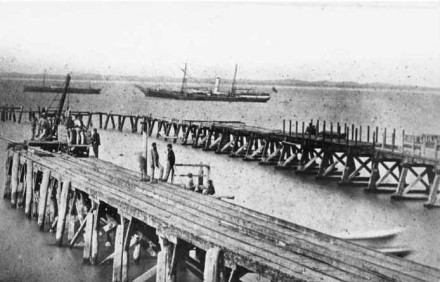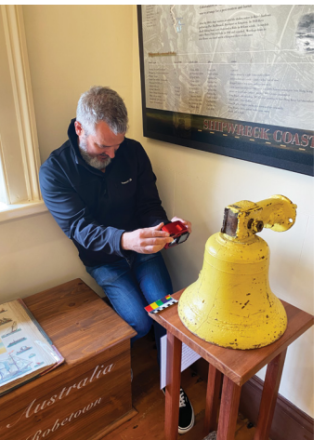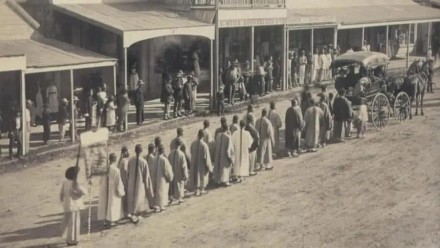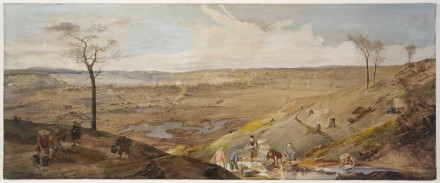History
The vessel departed on its final voyage in early June 1857, bound from
Hong Kong for South Australia with over 400 Chinese migrants. It arrived
at Robe on 25 June 1857, and its Chinese passengers were safely discharged the following day before commencing their arduous overland passage to the
gold fields. Due to inclement weather, Koning Willem de Tweede remained
sequestered in Guichen Bay and was still at anchor when it was struck
by a severe southwesterly gale on 30 June. Initially the anchors dragged,
but as the storm and seas intensified, the windlass was reportedly torn
from the weather deck.

This prompted the captain Giezen, to order the vessel’s crew to set sail to intentionally run it aground in shallows off Long Beach. Despite grounding on sand bottom close to shore, the storm’s severity caused the hull to quickly break up and led to the loss of 16 of its crew of 25 when one of the ship’s boats overturned in the surf. Giezen survived, but only through sheer luck, as he was unable to board the doomed boat and was later dragged to safety through the surf by a rope that he attached to a small barrel and floated to bystanders on shore.
Salvage
Some months afterwards, the wreck was sold to a resident of Robe, Jacob Chambers, for £225. Much of the wreck was reported to be salvaged, including two cannons and a swivel gun, the figurehead, bell, and several doors and pieces of timber from the hull.

The Caledonian Inn installed four of the ship's doors. A cannon which stands in front of the historic Customs House in Robe and the ship's bell used at the Robe Primary School from the late 1800s until the 21st century were reported as coming from Koning Willem de Tweede;[2] However, later researchers raised doubts about both. The cannon's design resembles a British type, and may be from Sultana, another ship wrecked near Robe on 28 April 1857
Chines cheap labour
Little-known maritime link between Australia and the Netherlands in the 1850s is the role of Dutch ships in transporting Chinese immigrants to the Victorian gold fields. The discovery of gold in Victoria in 1851 prompted hundreds of thousands of people from around the world to flock to the colony and seek their fortune. Among them were tens of thousands of Chinese, the majority of whom were men from the densely populated region surrounding the trading cities of Guangzhou, Hong Kong and Macau.

The rapid influx of Chinese migrants to Victoria aroused anxiety within the colony’s European population. In 1857 the Chinese miners outnumbered the European miners by at least 3 to 1 at the diggings in Victoria. The prevalence of Chinese workers at diggings resulted in anti-Chinese agitation and violent clashes. The violent riots took the lives of a number of Chinese workers.

With the result that the government passed the Chinese Immigration Act in June 1855 to limit the number of Chinese immigrants a vessel could carry. The Act also required ships’ masters to pay a £10 poll tax for each Chinese passenger brought to Victorian ports. Ultimately, the legislation failed to curb Chinese migration to the gold fields, as ships began landing passengers at Robe, the nearest non-Victorian port. From there, an estimated 17,000 Chinese walked more than 400 kilometres to reach the diggings in places such as Ballarat, Bendigo and Daylesford. Most ships that delivered Chinese immigrants to Robe were British or American, but the Dutch also played a significant role. In 1857 alone, five Dutch vessels arrived at
Robe with a combined consignment of about 2,000 Chinese passengers.
Description
Built: launched at the shipyard of Fop Smit in Kinderdijk, Netherlands, on 8 December 1840. Originally named Erfprinses van Oranje (Crown Princess of Orange),
Eigenaar: initially owned by the firm BJ Suermondt of Rotterdam, but by 1842
ownership had transferred to Pieter Varkevisser,
Historic shipwrecks in South Australian state waters are protected by the
South Australian Historic Shipwrecks Act 1981 and the Historic Shipwrecks
Regulations 2017 (DEW 2023)
| Master | Giezen, Hindrik Roelfs |
|---|---|
| People on board | 25 |
| Length | 140 feet (42.7 m) |
| Width | 39 feet (11.9 m) |
| Draft | 13 feet (4 m) |
| Tonnage | 800 ton |
Status
In May 2025 it was reported that the rest of the wreck of Koning Willem II had been located around 400 m (1,300 ft) off the beach in Robe, in fairly shallow water.
References
- Marhisdata ID 18522.
- The Australian National Maritime Museum (2024).
Wrecks and Relics. Looking after maritime archaeological finds in the Robe region. - Leydse courant 25-09-1857.
artikel Leydse courant.